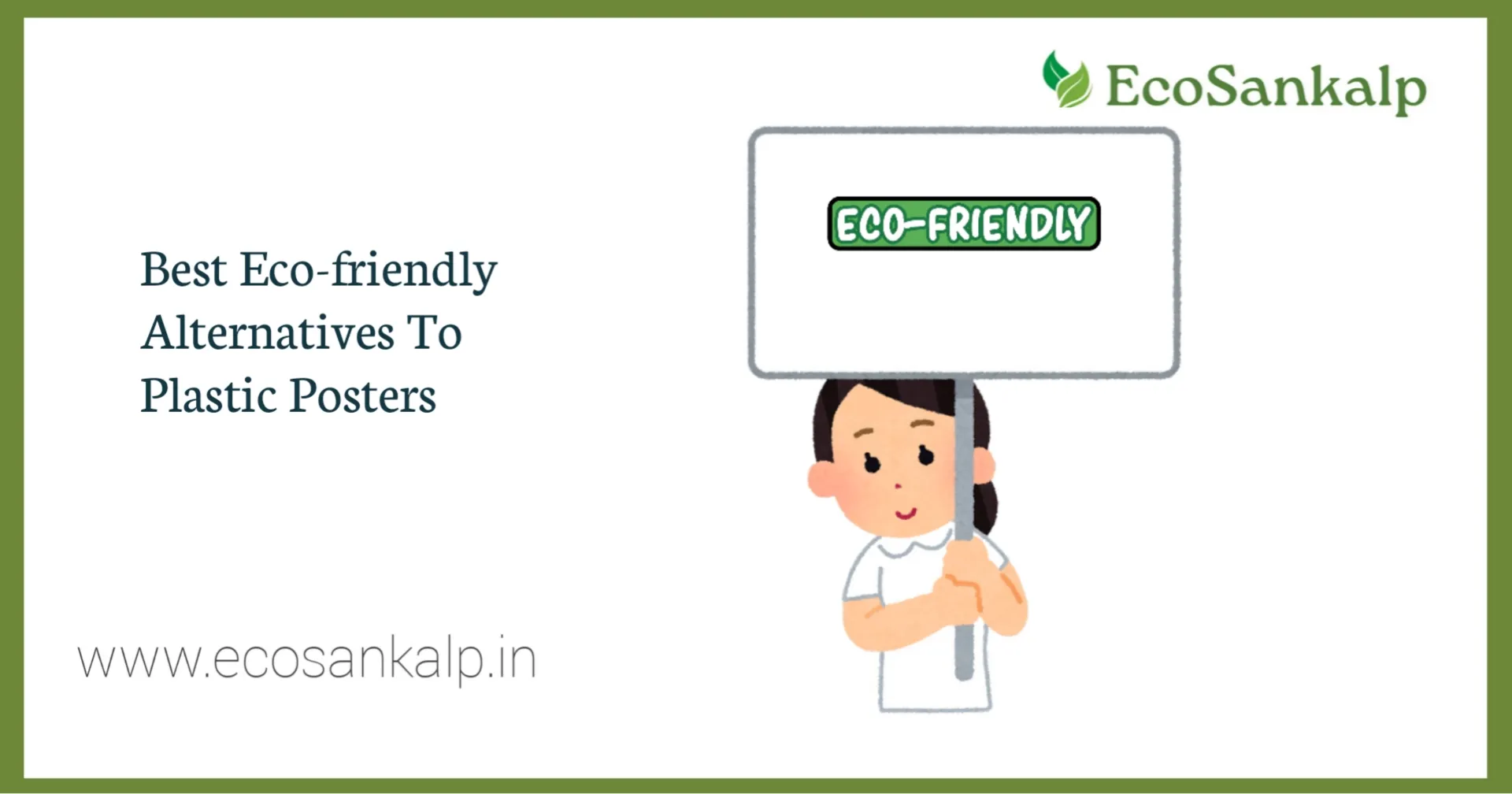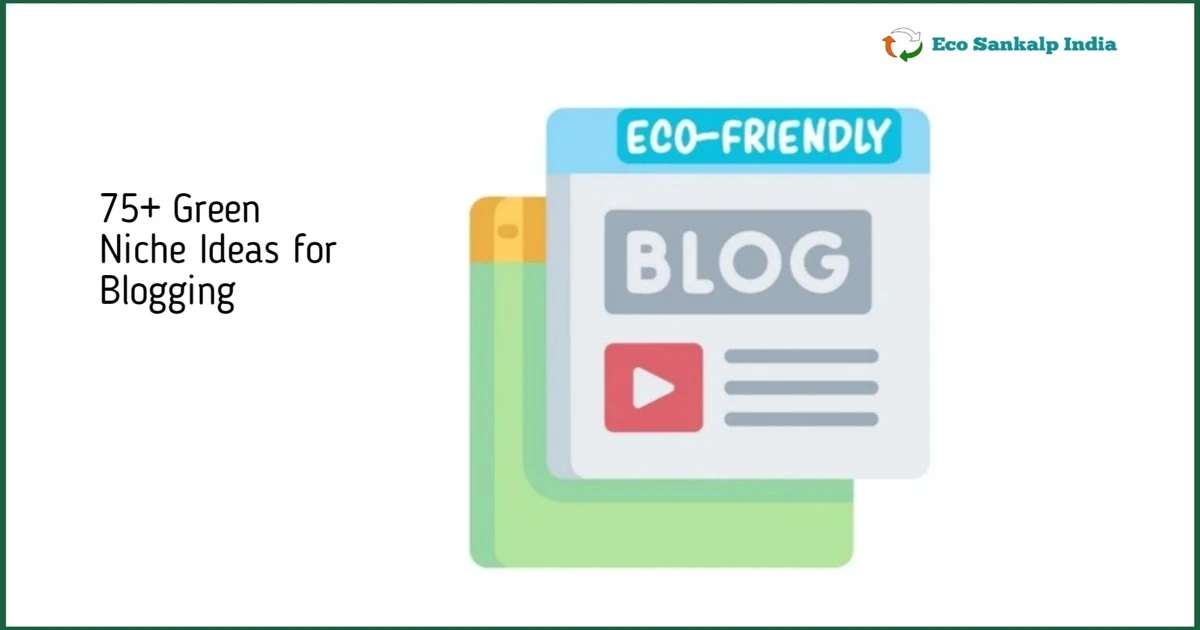In this information age, it is no more hidden from people around the world than how our daily activities can influence the ecosystem.
Due to the devastating effect of our unsustainable lifestyle on the environment and our health, now many people are embracing an eco-friendly lifestyle.
As more and more people are becoming aware of their carbon footprint, it is no wonder the eco-friendly landscape is getting higher traction and growing year by year.
The money spent on eco-friendly products and services has seen incredible growth in the past few years.
The eco-friendly niche is an emerging, profitable, futuristic, and evergreen niche to start a blog in 2024.
Let’s move towards a step-by-step guide on how to start a sustainability blog.
Page Contents
Why Start a Sustainability Blog?
Starting a sustainability blog could be both a rewarding and fulfilling way to share your daily lifestyle and eco ideas. People looking to start a sustainable lifestyle often look for guidance on how they can take care of our planet without discomfort.
Here are five surprising reasons why you start a sustainability blog:
1. Share Your Ideas: If you’re passionate about sustainable living, starting a sustainability blog will be an excellent way to express your eco-friendly experiences and ideas and build loyal followers.
2. Low Competitive: The digital landscape is rapidly expanding and becoming more and more competitive. Some niches are highly saturated like finance, business, health, self-development, and making money online.
If you’re looking for a relatively low competitive niche, then green niches are good options to pick in 2024. This niche is not yet highly competitive. Many green sub-niches are low-competitive and highly demanding.
3. Earning Potential: Eco-conscious people are often willing to pay for products and services that support their sustainability values. As a blogger, you will get endless eco-friendly products for affiliate marketing.
Yes, most sustainability blogs can be easily monetized by affiliate links. You can join one or more of the high-ticket eco-friendly affiliate programs that align with your niche and start promoting.
4. Engaging Audience: People catering to this niche are often excited to consume content and follow creators who guide them about sustainable living. Also, green niches are rapidly emerging and attracting novices seeking help in reducing their carbon footprint.
5. EverGreen: One of the most important points on why you start a sustainability blog is – green niches are evergreen.
An evergreen niche keeps its value and relevancy for a longer time or even decades. For example, sustainability is an evergreen niche that doesn’t become irrelevant until the end of the Earth. Yes, there might be changes in how specific practices have been done for the planet’s preservation.
How Successful Sustainability Blogs Looks Like?
Before moving forward, let’s take a look at successful sustainability blogs out there for inspiration. By visiting these blogs you’ll get an idea and blueprint for launching a successful sustainable blog.
1. Tree Hugger
Tree Hugger is a renowned name for providing quality content around sustainability. They cover a wide range of topics that can help us become more eco-friendly. TreeHugger is a one-stop hub for those who want to reduce their carbon footprint or those who need inspiration for thriving a blog.
2. Eco Wiser
Ecowiser is a perfect example for new sustainability bloggers. They’re a team of eco-conscious people who produce engaging content on eco-friendly living. Just in a year, this blog got significant reach through its quality and informative content that makes people come back for more.
3. Sustainable Jungle
Sustainable Jungle is more than just a blog, it is a hub for people seeking eco-friendly ideas. They cover a wide range of topics that cater to almost every individual striving to contribute to planet preservation. You will get to learn a lot of things if you’re looking to launch a sustainability blog.
How To Start a Successful Sustainability Blog?
This section provides you with a step-by-step guide to building your own sustainability blog from scratch:
- Select a Niche
- Register a Domain Name
- Buy Web Hosting
- Choose Blogging Platform
- Choose a Elegant Theme
- Design Your Blog
- Take Advantage of Plugins
- Create Important Pages
- Start Content Creation
- Promote Your Blog
- Monetize Your Blog
Step 1: Select a Niche
First of all, you have to choose a niche centered around sustainability. Your niche should be interesting to you as well as narrowed down that address specific problems. This helps you gain credibility faster and easier than targeting multiple topics. However, you can expand and cover multiple topics as your blog grows.
For instance, instead of targeting the broader sustainable fashion niche, initially choose something specific like ‘sustainable fashion for women’. Make sure you haven’t chosen a niche that is too narrow has less volume or has insufficient content ideas.
How to choose a niche?
Firstly, pick a niche you’re expert in and have experience with. Sometimes, having an extensive interest in the subject will be enough for outstanding content creation for a blog.
Secondly, check the search volume of the keyword niche using the free Semrush SEO tool.
- Open Semrush in your browser and create an account.
- Search your keyword in the top search bar. For instance, ‘zero waste‘
- Ensure abundant search volume and enough content ideas!
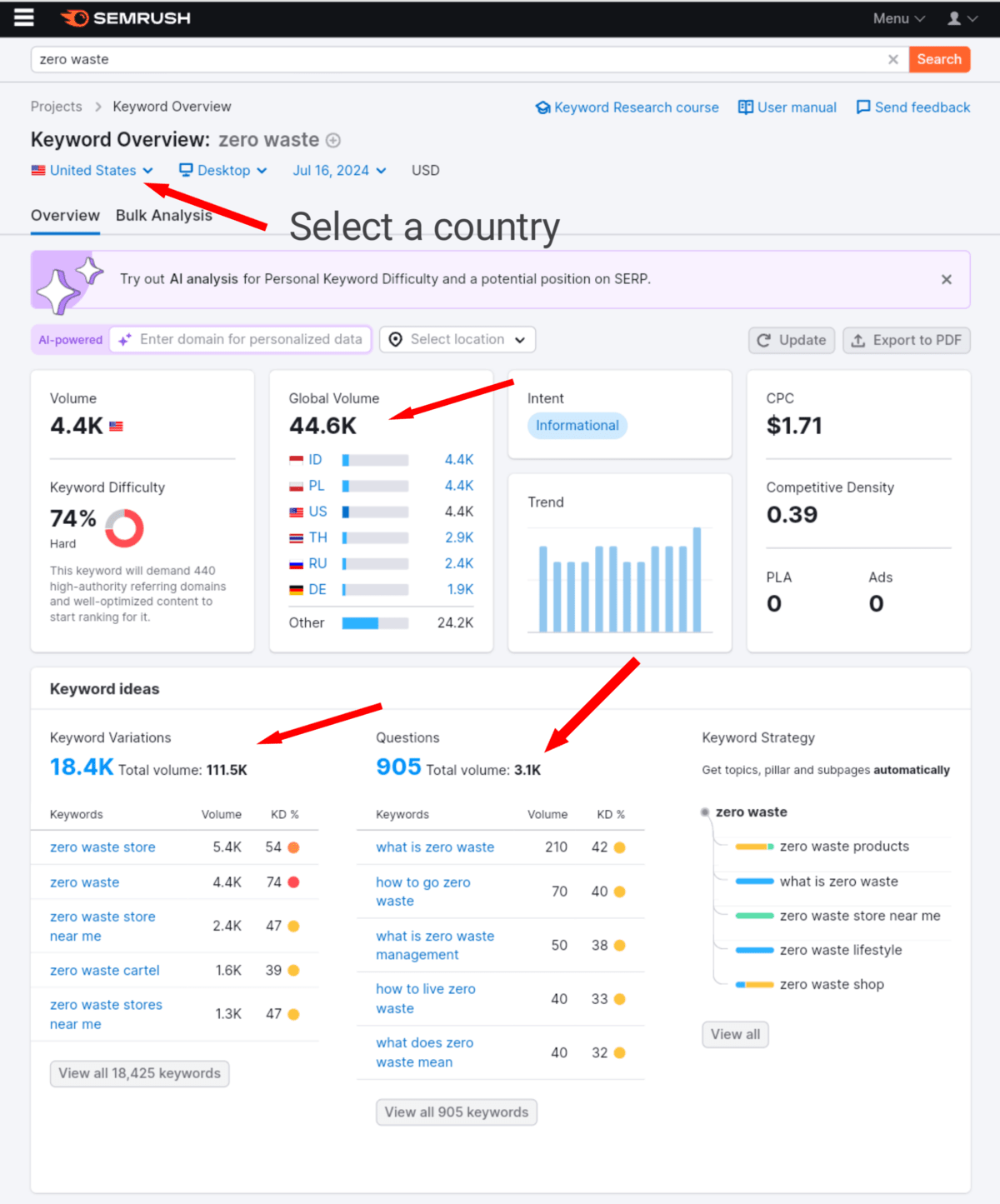
Lastly, ensure your niche is easily monetizable in various ways including display ads and affiliate links.
Step 2: Choose a Blogging Platform
In this step, you need to choose a blogging platform. There are many zero-cost blogging platforms like Blogger or Medium where you don’t need to invest in hosting but with limitations. You will not have full control of your content or website.
That’s why I suggest a self-hosted blog on advanced platforms like WordPress, Wix, Squarespace, and more. With these platforms, you can create the blog you ever dream of. They provide an extensive array of customization options, plugins, and themes that not only make your blog look professional but also help you format and design your each blogposts.
To make you more clear, I strongly recommend you go with WordPress as it is beginner-friendly and highly customizable. Ecosankalp.in and more than 43% of websites use WordPress.
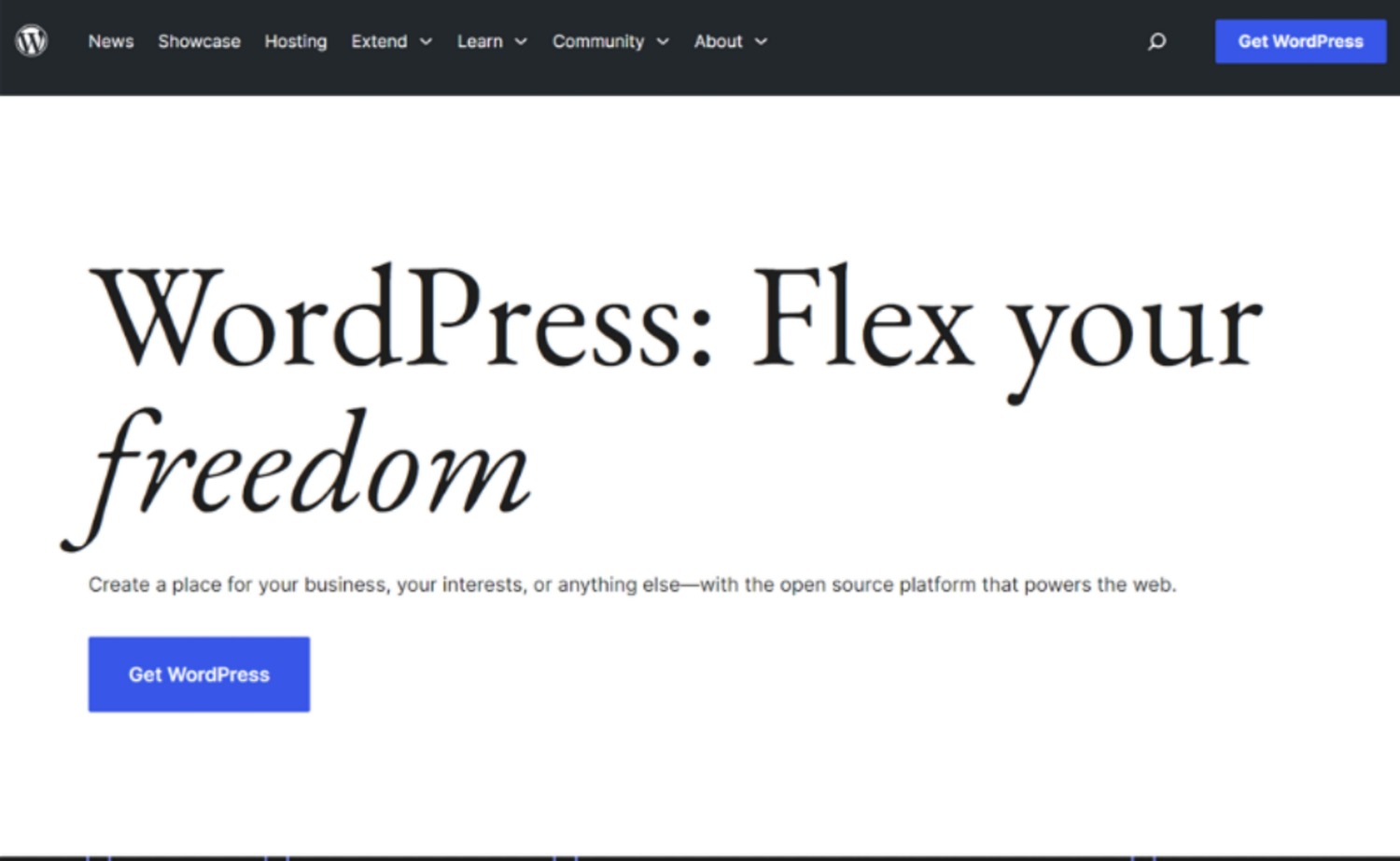
Step 3: Register a Domain Name
Moving one step forward, now it’s time to come up with a short, memorable, and catchy domain name. It can either be inspired by your creativity or auto-generated using domain name generator tools.
How to come up with a good domain name?
- Incorporate keywords: You should use keywords based on your niche in your domain name. For instance, ‘GreenFuture‘ explicitly conveys its commitment to sustainability for a greener future.
- Easy to remember: Choose a short and memorable domain name ideally between 6-14 characters.
- Secure Top-Level Extensions: You should look for domains with top-level extensions like .com/.org/.uk/.us/.ca/.in etc.
- Check Trademark: Do a trademark search to ensure your domain name does not belong to another entity.
After that, you can register your domain name on Godaddy, Namecheap, or any other platform of your choice.
Best Sustainability Domain Names that are Available:
- EcoRiseUp.com
- GreenWaveGuide.com
- Greenmindsmatters.com
- GreenBeaconGuide.com
- Style.eco
- Greenvogue.uk
- Ecofashionista.in
- EcoEthicalStyle.com
- EcoPowerPath.com
- EcoWattWorld.com
Step 4: Buy Web Hosting
Unless you’re not starting a blog on a free blogger or medium, you need web hosting. Web hosting is a service for the storage of files, data, and all the content you will publish on your website.
Good hosting plays a crucial role in blogging success as they are secure, never goes down, and makes your website fast-loading, so you will be relaxed and focus on content creation for maximum reach.
Many web hosting services are excellent in terms of performance. There are also plenty of green web hosting services that are eco-friendly as they prioritize sustainability in their businesses.
Best web hosting for sustainability blogs:
- Bluehost: Most popular and affordable hosting!
- GreenGeeks: Best eco-friendly web hosting services for blogs.
- Hostinger: Best beginner-friendly hosting services.
- SiteGround: Best premium hosting for better performance.
Step 5: Choose an Elegant Theme
If you’ve chosen the WordPress platform, you have hundreds of free and paid themes to choose from. A theme provides you with a design and layout to our blog. You’re allowed to pick any and install any theme on your website. However, while choosing a theme, you have to take care of many things to fully optimize your blog.
Here are some features of a good wordpress theme:
- Lightweight
- Mobile-friendly
- Easy to Navigate
- Easy to Customize
- Secure and Trusted
- Great Support System
Although there are 100 themes available for the WordPress website, I would like to recommend by top 3 favorite themes that are Astra (my personal choice), GeneratePress, and Kadence. They are lightweight, easy to customize, offer tons of pre-built designs, and are user-friendly.
Steps to install and activate a theme in WordPress:
- Step 1: Log in to WordPress.org using username and password.
- Step 2: Navigate to Appearance section and click on ‘Themes ‘
- Step 3: Click Add New and search your intended theme (eg. Astra) in the search bar.
- Step 4: After that, click on the theme showing below and click to install then activate it.
Step 6: Design Your Blog
Once you have activated a theme successfully, it’s time to give a catchy look to it. For that, you have to customize your theme by visiting the theme customization section in WordPress. There are multiple ways to design your blog – without plugins or with the help of plugins.
In Astra, you can install a plugin called Spectra and seamlessly provide your blog with a professional look. Spectra is a plugin from the same company that built an Astra theme.
- Upload your custom eco-friendly logo and site icon. You can easily design a brandable logo using Canva.
- Choose a color scheme for your blog. For a sustainability blog, it looks always best with a green color combination.
- Choose a body font that is clear and easy to read.
- Make your headings catchy. You can give a color Zucchini (#07431b) for a sustainability-inspired look.
- Create a beautiful footer section with proper navigation.
- Avoid using too many colors, designs, blocks, and fonts, and ensure a clean and minimalist look.
Step 7: Take Advantage of Plugins
Plugins are very helpful in WordPress blogs. They can add some extra functions to your website so you can create more compelling content. However, using too many plugins can bring a lot of site speed and security problems. That’s why it is always best to use minimal plugins that are also trustworthy.
Here are some important plugins you can install on your website:
- Rank Math: It is a plugin helpful for Search Engine Optimization.
- Easy Table of Contents: A plugin that provides a content outline with links so visitors can quickly jump to the particular section they want.
- Wordfence: A security plugin that prevents hacking!
- LiteSpeed Cache: High-performance page caching and site optimization.
- Smush: For image lazy load and optimization for faster page load.
Step 8: Create Important Pages
Head over pages section in your WordPress click add new and create essential pages.
Some of the necessary pages you need to create our home page are privacy policy, about us, contact us, terms and conditions, and disclaimer.
Home Page: The home page is a type of landing page where people land when they hit your website URL. It should be well customized, authentic, and linked with all the posts and pages on your website.
About Us: As it’s name tells About Us page includes information about you and your blog. On this page you can share your stories, what to expect, and the reason for starting a sustainability blog. This helps your users know about you and further increases your blog’s trustworthiness.
Contact Us: It is a necessary page to show on your website for users interested in contacting you for any personal or business reasons.
Privacy Policy: This is the most important page you must have in your blog. On this page you need to define user’s rights, user information you collect, children’s data protection, and overall site behavior. According to Google, this is a compulsory page for a blog or website.
Terms and Conditions: This page includes a statement users need to agree to while using your website. The statement includes user’s rights, use of the content, and limitations of liability.
Disclaimer: Having a disclaimer page is essential to limit the liability of your blog. Unless you’re not a professional or degree holder of the subject you’re talking about, always clarify that the information provided on the site is for general informational purposes only and shouldn’t be taken as professional and legal advice. The disclaimer page also includes the disclosure of your relationship with brands and links linking to external sites.
Step 9: Start Content Creation
Congratulations, you’ve done the blog set-up part! Now it’s time to start creating content around the niche you’ve chosen earlier.
To start content writing you need to do keyword research using SEO tools. No worries, there are numerous free tools to leverage while keyword research.
For instance, SEMrush is an advanced keyword research tool that could be very helpful in your blogging journey. Ahrefs, Google Keyword Planner, Google Trends, Ubersuggest, etc. are a few more tools to explore.
Follow this step for keyword research using Semrush.
- Visit Semrush.com
- Create Account
- Navigate to Keyword Magic Tool
- Search with seed keywords to find low competitive keywords around it.
For example, here are a few low competitive content ideas I found for the seed keyword ‘zero waste kitchen‘.
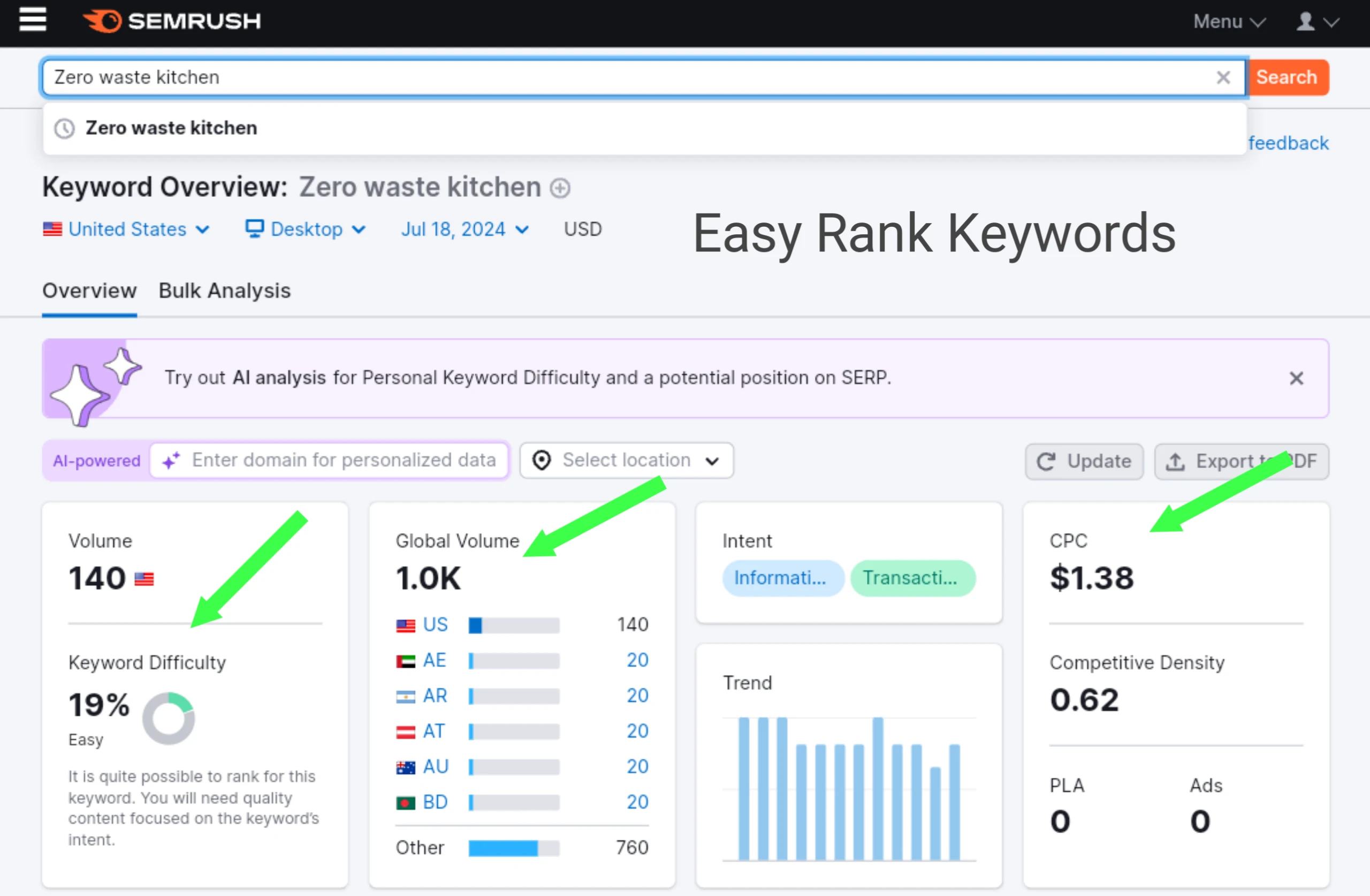
Blog Posts Ideas for ‘Zero Waste Kitchen‘.
- How to start composting in kitchen?
- How to achieve zero waste in kitchen?
- 13 best zero waste kitchen products.
- 10 zero waste recipes to try!
- A guide to zero waste kitchen shopping.
Step 10: Promote Your Blog
Blog promotion is an important aspect of blogging that helps your blog earn quality backlinks. While writing and publishing SEO-friendly blog posts, you need to promote your blog side by side. SEO takes time to show results, so in the meantime follow these tips to promote your sustainability blog:
- Create Social Media Accounts: Create a dedicated page for your blog on social media platforms such as Instagram, Facebook, Pinterest, X, and more.
- Join Community: Connect with eco-friendly online communities and share your blog there.
- Collaborate with Bloggers: Try to connect with other sustainability bloggers and influencers and build strong relationships with them.
Step 11: Monetize Your Blog
There are several monetization opportunities in sustainability blogging. Let’s have a quick look at some of the best methods.
Display Ads:
It is the easiest method to start earning from a blog. You need to join advertising platforms like Google Adsense, Ezoic, Mediavine, or Media.net to serve ads on your blog and make money per view.
- Earning capacity low-medium
- Not user-friendly
- Best for beginner bloggers to start earning online.
Affiliate Marketing:
Affiliate Marketing is one of the best methods to earn from blogs for intermediate-professional bloggers. Experienced bloggers even make more than $100000/m from promoting other’s products through their blogs.
- Earning potential medium-high
- Needs proper content strategies to bring conversions
- Passive income source
Sell Own Info Products:
Not everyone can be a manufacturer, but it is possible to create info products or courses that help people. For example, a sustainability blogger can create various courses on different topics like cut-plastic, zero-waste living, water-conservative life, sustainable fashion hack, organic beauty, organic farming, sustainable shopping tips, and more catering to eco-conscious audiences.
- Earning potential is high
- Requires time and effort to create courses
- Requires good writing skills
Conclusion
Starting a sustainability blog could be a smart decision as it is an emerging topic. Many people around the world adopting an eco-friendly lifestyle, so it is no wonder the content demand for eco-friendliness is rising.
The complete roadmap for starting a thriving sustainability blog is written above. You can easily create your self-hosted blog by following the steps from starting.
Hard work with consistency is key to success in any field including blogging. There is no shortcut, so start working from today!
I hope this blog post is helpful to you!
